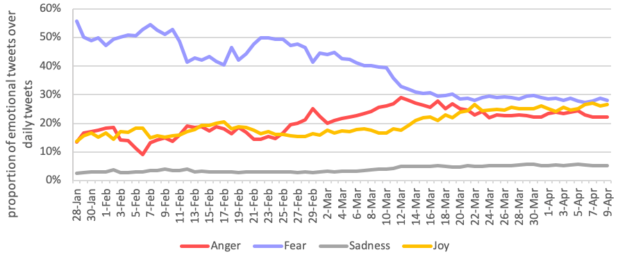We were told that the lockdown was needed in order to prevent too many people from catching the coronavirus at once and overwhelming the hospitals, but then we learned that doctors spent most of their workday practicing dance moves for social media, that it was mostly the very old and sick who were at risk, and that the lockdown is actually weakening people’s immune systems.
It’s amazing that people are not straight-up revolting yet.
For many people stuck in lockdown, social media is their best outlet for staying in contact with the world. As the coronavirus pandemic continues to spread, fear of the illness remains high. Unfortunately, a new study finds that fear is turning into anger as the global community anxiously waits for a cure.
Researchers at Nanyang Technological University are studying the shift in emotions being expressed on Twitter during the pandemic. Their analysis of more than 20 million tweets finds nearly 60 percent of online reaction expressed fear and uncertainty about the virus in January amid the start of the pandemic.
Since then, fearful tweets continue to drop while messages expressing anger are on the rise. The study in JMIR Public Health & Surveillance adds angry coronavirus posts made up nearly 30 percent of Twitter reaction on March 12. That is the same day the World Health Organization officially declared COVID-19 a global pandemic.
The NTU team says this shift reflects growing frustration with national quarantines; as people express anger over their isolation and social seclusion. Governments must do a better job of communicating with the public to keep these frustrations from boiling over.
“The rapid evolution of global COVID-19 sentiments within a short period of time points to a need to address increasingly volatile emotions through strategic communication by government and health authorities, as well as responsible behavior by netizens before they give rise to ‘unintended outcomes,’” Professor May O. Lwin says in a university release.
Lwin suggests not addressing the public’s anger can lead to growing mistrust of how officials are handling the emergency. Belief in false news reports found online is also likely to rise, hindering global recovery efforts.
…
The analysis reveals tweets expressing joy have nearly equaled fearful tweets as of May. These social media users are talking about national pride and community spirit. They use words like “good news” and “feel good” as more people recover from the illness. In Singapore, the study finds many of these comments revolve around resilience to COVID-19 and celebrating heroic or kind acts.
What the authors are saying is that the government should kick the hysteria and brainwashing up a notch in order to keep people in the “fear and comply” state.
The idea that “belief in false news reports found online” that somehow contradict the official government position could hinder “global recovery efforts” is preposterous.
There are plenty of actual studies by actual scientists showing that coronavirus is really just a flu-tier virus (1, 2, 3) and that the lockdown is not really doing anything but destroying the economy and people’s lives (1, 2).
Most people who know anything about anything and are not directly employed by the government are pointing out that this pandemic is nothing but a blatant, giant, and stupid hoax.


